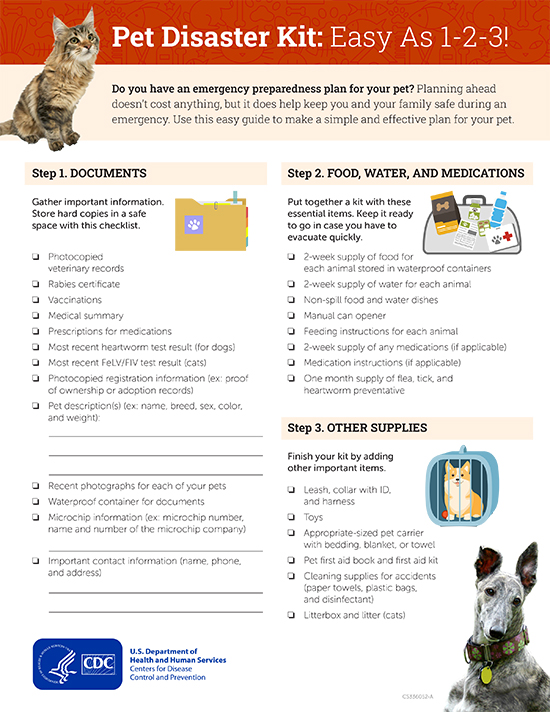How to Prepare Your Pet for Emergencies: A Step-by-Step Guide

Introduction
Emergencies can happen at any time, and as pet owners, it is our responsibility to ensure the safety and well-being of our furry friends. Just like we prepare ourselves and our families for unexpected situations, it is equally important to have a plan in place for our pets. This step-by-step guide will provide you with valuable information on how to prepare your pet for emergencies, ensuring that you are ready to face any unforeseen circumstances together.
1. Create an Emergency Kit for Your Pet
Having a well-stocked emergency kit for your pet is crucial in times of crisis. Include essential items such as:
- Food and water for at least three days
- Medications and medical records
- Leash, collar, and identification tags
- Blankets and towels
- First aid supplies
- Recent photos of your pet
2. Know Your Pet’s Safe Spots
Identify safe areas in your home where your pet can seek shelter during emergencies. Make sure these spots are easily accessible and free from potential hazards. Train your pet to go to these safe spots on command.
3. Microchip Your Pet
Microchipping your pet is a permanent form of identification that can greatly increase the chances of being reunited in case of separation during emergencies. Ensure your contact information is up to date with the microchip company.
4. Plan for Evacuation
Develop a detailed evacuation plan that includes your pet. Identify pet-friendly hotels or shelters in your area and keep a list of their contact information. Practice evacuating with your pet to familiarize them with the process.
5. Arrange a Pet Caregiver

In case you are unable to care for your pet during an emergency, have a trusted friend, family member, or neighbor who can step in as a temporary caregiver. Share your emergency plan and provide them with a spare key to your home.
6. Keep Important Documents Handy
Store copies of your pet’s medical records, vaccination certificates, and identification documents in a waterproof container. Keep this container with your emergency kit for easy access.
7. Prepare for Specific Emergencies
Consider the potential emergencies your area is prone to and prepare accordingly. For example, if you live in an earthquake-prone region, secure heavy furniture and install pet-friendly earthquake straps to prevent injuries.
Summary
Emergencies can be stressful and chaotic, but having a well-thought-out plan can make all the difference in ensuring the safety of your beloved pet. This step-by-step guide will walk you through the essential preparations needed to keep your pet safe during emergencies.
The guide begins by emphasizing the importance of identification. Ensuring that your pet has proper identification, such as a collar with tags or a microchip, greatly increases the chances of being reunited if you become separated.
Next, the guide covers the creation of an emergency kit specifically tailored for your pet. This kit should include essential items such as food, water, medications, and comfort items to help reduce stress during an emergency.
Additionally, the guide provides valuable information on creating a pet-specific emergency plan. This includes identifying safe areas within your home, designating a caregiver, and having a list of emergency contacts readily available.
Lastly, the guide emphasizes the importance of practicing your emergency plan. Conducting drills and familiarizing your pet with the process will help reduce anxiety and ensure a smoother response during an actual emergency.
By following this step-by-step guide, you can rest assured that you have taken the necessary precautions to keep your pet safe duri try this web-site ng emergencies. Remember, being prepared is the key to protecting your furry friend and providing them with the care they need in times of crisis.
- Q: Why is it important to prepare my pet for emergencies?
A: It is important to prepare your pet for emergencies to ensure their safety and well-being during unexpected events such as natural disasters or accidents. - Q: What should I include in my pet’s emergency kit?
A: Your pet’s emergency kit should include essential items such as food, water, medications, veterinary records, a leash, a carrier, and comfort items like blankets or toys. - Q: How can I create a pet emergency plan?
A: To create a pet emergency plan, identify potential risks in your area, designate a safe place for your pet to stay, have a list of emergency contacts, and ensure your pet is properly identified with tags or microchips. - Q: Should I have a backup caregiver for my pet?
A: Yes, it is recommended to have a backup caregiver for your pet in case you are unable to care for them during an emergency. This can be a trusted friend, family member, or a professional pet sitter. - Q: How can I help my pet stay calm during emergencies?
A: To help your pet stay calm during emergencies, create a familiar and secure environment, use calming techniques such as playing soothing music, and consider using anxiety-reducing products like pheromone sprays or calming wraps.

